By following this technique, even novice cooks can whip up fool-proof, restaurant-quality seared steaks at home. Yes, the perfect Whole30 steak!

I rarely cook steaks these days. Don’t get me wrong: there’s nothing quite like a juicy, dry aged, 100% grass fed slab of meaty perfection. But let’s face it: prime cuts like steak are pricey. So when I throw down a stack of bills in exchange for the best meat I can afford, there’s no way I’m going to take my chances with an unreliable recipe. My mama didn’t raise no sucker.
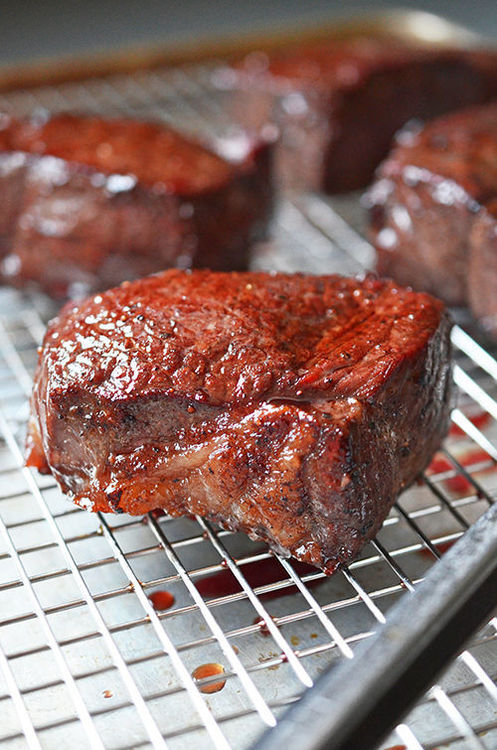
Longtime readers know that back in the day, I was all about cooking steaks (and, well…just about everything else) sous vide. And sure—cooking with a temperature-controlled water bath guarantees a properly-cooked steak every time. But as many of you have pointed out, not everyone has an immersion circulator. (Really: I’ve gotten the message. That’s why the last sous vide recipe I posted was back in 2011, believe it or not.)
So: how do you perfectly cook a steak with basic kitchen tools? The answer is in the fabulous new cookbook by the obsessive food nerds at America’s Test Kitchen: The Cook’s Illustrated Meat Book!
Here’s the thing: it’s not about fancy pan sauces or marinades, folks. Instead, you want to highlight the inherent primal beefiness of the steak by cooking it to the proper temperature—end to end—and sealing the deal with a uniform sear on the outside.
The key steps are simple: season the meat with salt and pepper, roast it in a low oven until it reaches the correct temperature, and sear the steaks in a screaming-hot skillet. By following this technique, even novice cooks can whip up fool-proof restaurant-quality seared steaks at home.
Ready to make the perfect steak?
Serves 4
Ingredients:
- 2 (1-pound) boneless strip steaks, 1½ to 1¾ inches thick, trimmed
- Diamond Crystal kosher salt
- freshly ground black pepper
- 1 tablespoon ghee
Kitchen Tools:
Steps:
Buy the best dang steaks you can find locally.
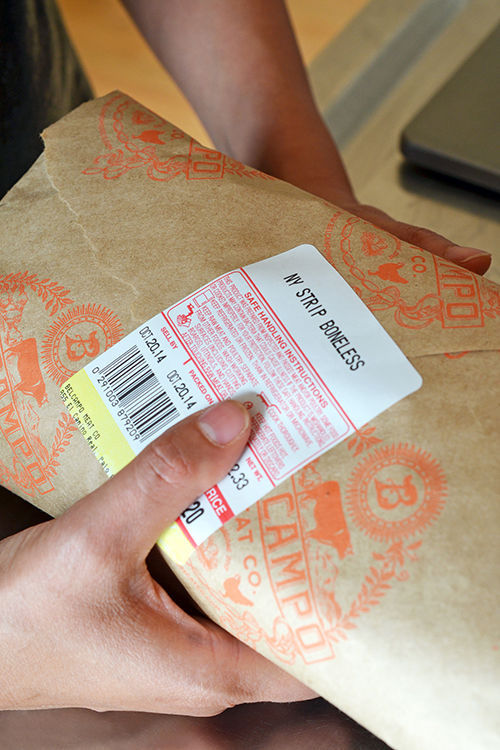
Heat the oven to 275˚F with the rack in the middle position.
Pat your steaks dry with paper towels…
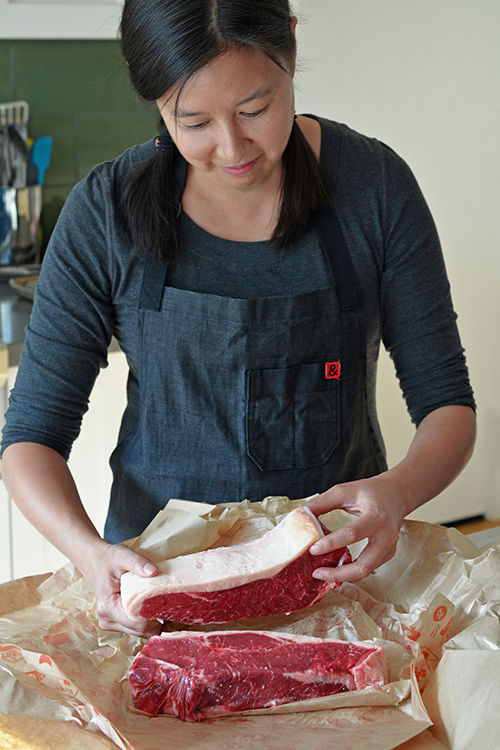
…and trim off the excess fat and silverskin if your butcher hasn’t already done it for you. Fat adds flavor, but too much will cause tons of splatter when you sear the steaks. I’m all for streamlining the cooking and cleaning process. (Because with Henry at work until late, I have to do both. *grumble grumble*)
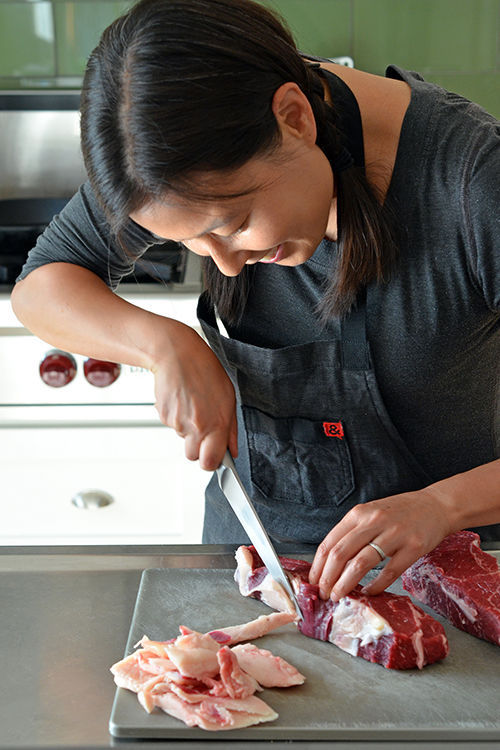
Cut each of your steaks in half vertically so that you have four even portions.
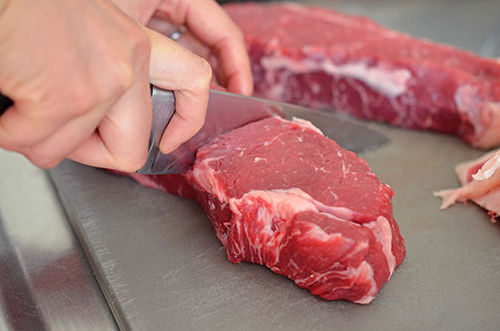
Voila!
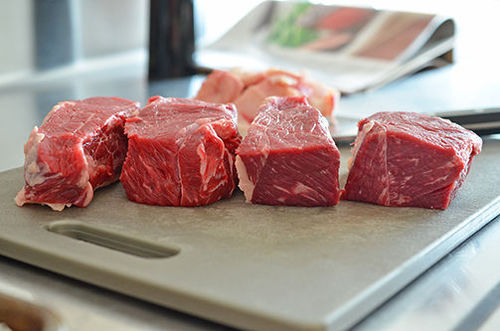
Combine some salt and pepper in a bowl…
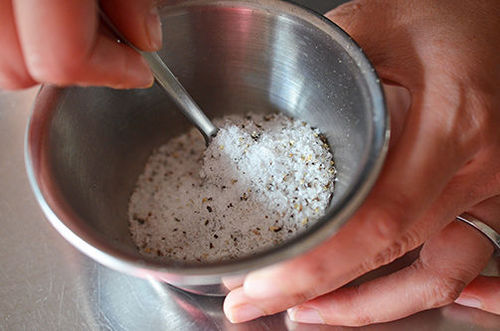
…and sprinkle it all over the surface of the steak.
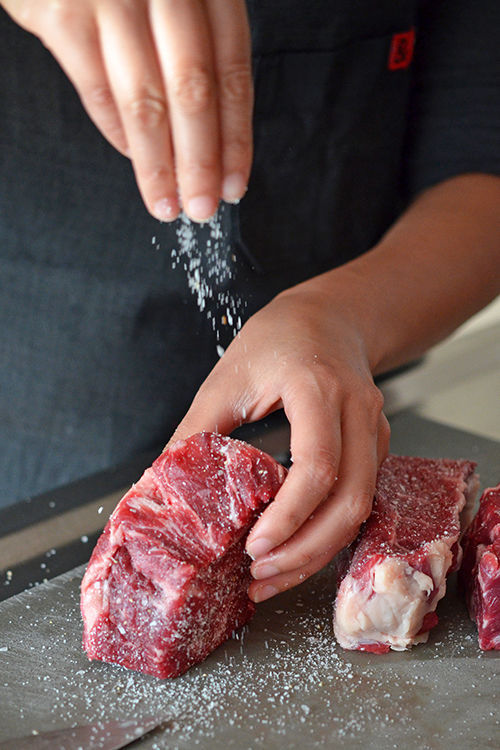
Place the steaks on a wire rack set in a rimmed baking sheet.
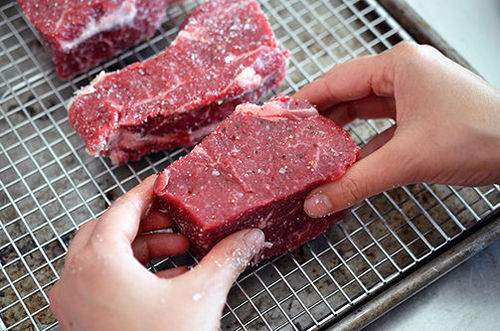
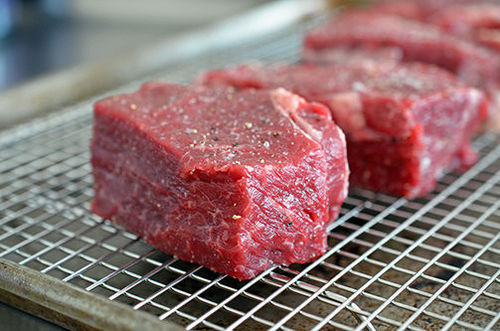
Yeah, we all know about testing the doneness of steaks by poking at the heel of your hand or even your FACE, but these methods are just not reliable enough for me. (After all, I have skinny hands but a big fat face, as pointed out by some online commenters. And my mother. All out of love, I’m sure.)
The only way to ensure properly cooked steaks is to verify the temperature with a meat thermometer. I’m kind of compulsive about this, so I use an in-oven thermometer that monitors the meat’s temperature while it’s cooking—and then I double-check at the end with a Thermapen.
If you’re using an in-oven thermometer, stab the center of a steak with the probe, and stick the tray in the oven. (Just so there’s no confusion: the display unit stays outside of the oven. No one wants to clean out hunks of melted plastic from the oven.)
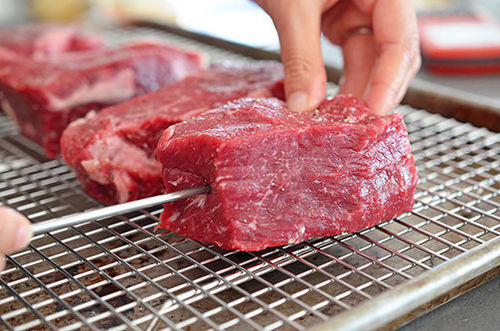
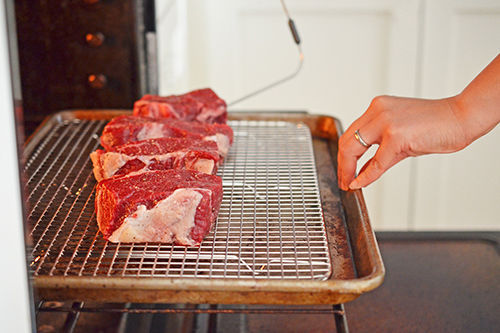
Cook until the meat registers 90˚F to 95˚F (for rare to medium-rare), about 20 to 25 minutes.
Prefer your steaks medium? Then take them out when the temperature reaches 100˚F to 105˚F (about 25 to 30 minutes). The folks at America’s Test Kitchen didn’t give instructions for medium well or well done ’cause we’re making PERFECT steaks, remember?
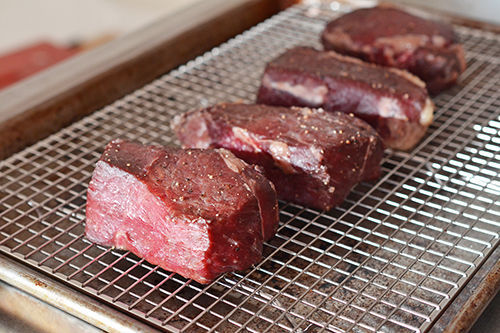
Brace yourselves: when you first remove the steaks from the oven, they’ll look unappetizing.
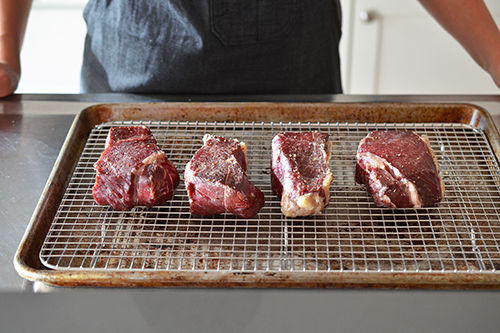
But don’t worry. They’ll be camera-ready in a few minutes.
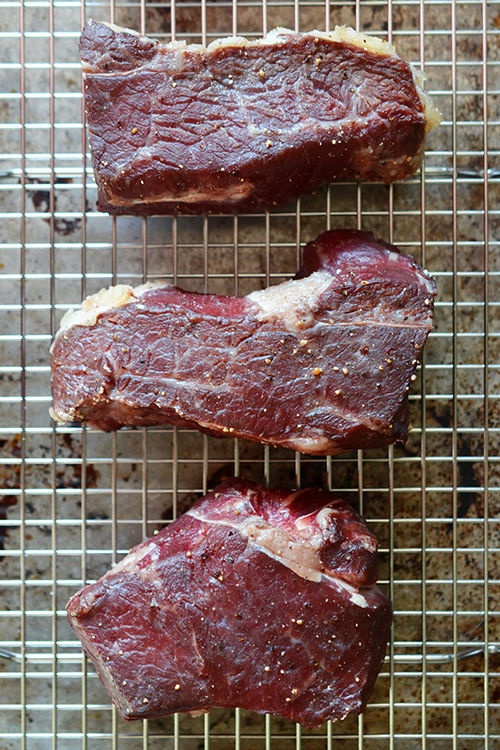
Heat a 12-inch cast iron skillet over high heat. Once the pan is super hot, swirl in the ghee and place the steaks in the skillet.
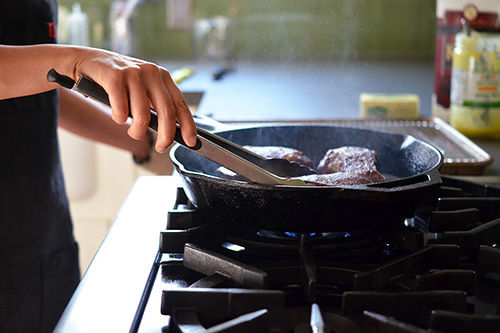
Sear the steaks on the top and bottom until evenly browned and crusty, about 2 minutes on each side. Don’t fiddle with them too much.
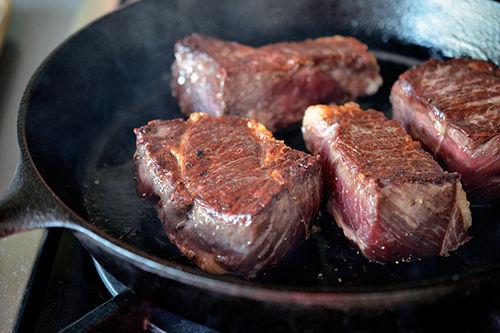
Transfer the steaks to a clean wire rack, and reduce heat to medium.
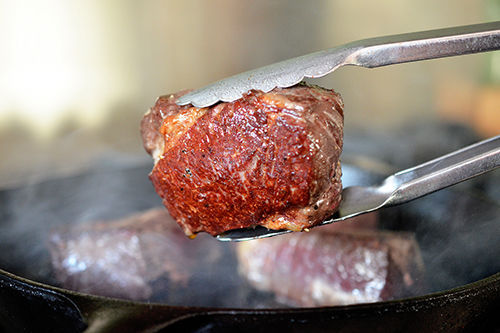
Using a pair of tongs, grab two steaks side-by-side, and sear the edges for about 20 seconds each.
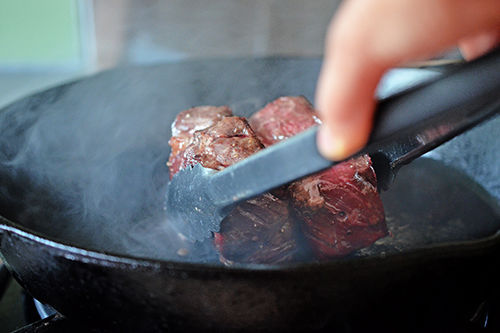
Transfer the steaks to a wire rack, and tent loosely with a piece of foil.
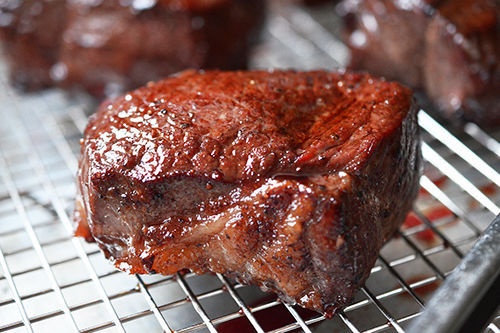
Sear the edges of the remaining two steaks. When they’re done, rest the meat for at least 10 minutes before you slice into them.
If you carefully followed all the instructions, you’ll be richly rewarded with tender, flavorful, perfectly-cooked steak.
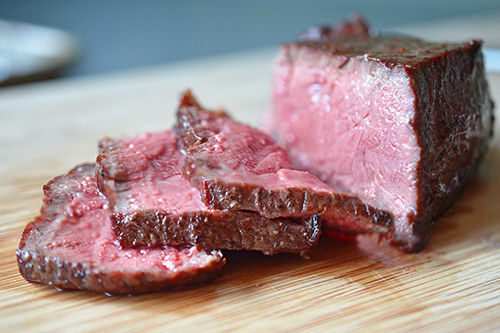
Feeling fancy? Sauté some mushrooms in the skillet and make a pan sauce with some red wine. (You can modify the pan sauce recipe from Weeknight Roast Chicken.) Then, serve your steaks with my favorite vegetable sides, World’s Best Braised Green Cabbage and Broiled Prosciutto-Wrapped Asparagus Spears.
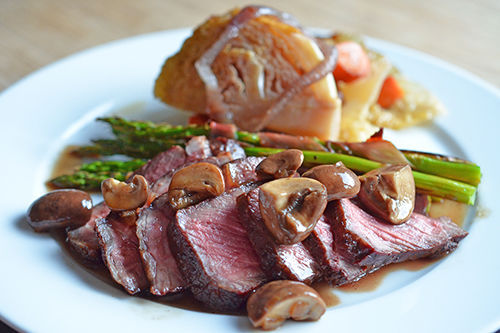
The Cook’s Illustrated Meat Book is my new go-to reference for all things meaty. Get your own copy and dominate the animal proteins in your kitchen!
Looking for more recipe ideas? Head on over to my Recipe Index. You’ll also find exclusive recipes on my iPhone and iPad app, and in my cookbooks, Nom Nom Paleo: Food for Humans (Andrews McMeel Publishing 2013), Ready or Not! (Andrews McMeel Publishing 2017), and Nom Nom Paleo: Let’s Go! (Andrews McMeel Publishing 2021).
PRINTER-FRIENDLY RECIPE CARD
How To Make The Perfect Steak

Ingredients
- 2 1-pound boneless strip steaks, 1½ to 1¾ inches thick, trimmed
- Diamond Crystal kosher salt
- freshly ground black pepper
- 1 tablespoon ghee
Instructions
- Heat the oven to 275˚F with the rack in the middle position.
- Pat your steaks dry with paper towels and trim off the excess fat and silverskin if your butcher hasn’t already done it for you. Fat adds flavor, but too much will cause tons of splatter when you sear the steaks.
- Cut each of your steaks in half vertically so that you have four even portions.
- Combine some salt and pepper in a bowl and sprinkle it all over the surface of the steak.
- Place the steaks on a wire rack set in a rimmed baking sheet.
- Yeah, we all know about testing the doneness of steaks by poking at the heel of your hand or even your FACE, but these methods are just not reliable enough for me. (After all, I have skinny hands but a big fat face, as pointed out by some online commenters. And my mother. All out of love, I’m sure.)
- The only way to ensure properly cooked steaks is to verify the temperature with a meat thermometer. I’m kind of compulsive about this, so I use an in-oven thermometer that monitors the meat’s temperature while it’s cooking—and then I double-check at the end with a Thermapen.
- If you’re using an in-oven thermometer, stab the center of a steak with the probe, and stick the tray in the oven. (Just so there’s no confusion: the display unit stays outside of the oven. No one wants to clean out hunks of melted plastic from the oven.)
- Cook until the meat registers 90˚F to 95˚F (for rare to medium-rare), about 20 to 25 minutes.
- Prefer your steaks medium? Then take them out when the temperature reaches 100˚F to 105˚F (about 25 to 30 minutes). The folks at America’s Test Kitchen didn’t give instructions for medium well or well done ’cause we’re making PERFECT steaks, remember?
- Brace yourselves: when you first remove the steaks from the oven, they’ll look unappetizing.
- But don’t worry. They’ll be camera-ready in a few minutes.
- Heat a 12-inch cast iron skillet over high heat. Once the pan is super hot, swirl in the ghee and place the steaks in the skillet.
- Sear the steaks on the top and bottom until evenly browned and crusty, about 2 minutes on each side. Don’t fiddle with them too much.
- Transfer the steaks to a clean wire rack, and reduce heat to medium.
- Using a pair of tongs, grab two steaks side-by-side, and sear the edges for about 20 seconds each.
- Transfer the steaks to a wire rack, and tent loosely with a piece of foil.
- Sear the edges of the remaining two steaks. When they’re done, rest the meat for at least 10 minutes before you slice into them.
- If you carefully followed all the instructions, you’ll be richly rewarded with tender, flavorful, perfectly-cooked steak.
Notes
Nutrition
Nutrition information is automatically calculated, so should only be used as an approximation.
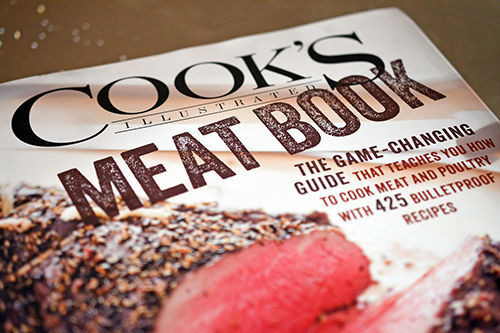
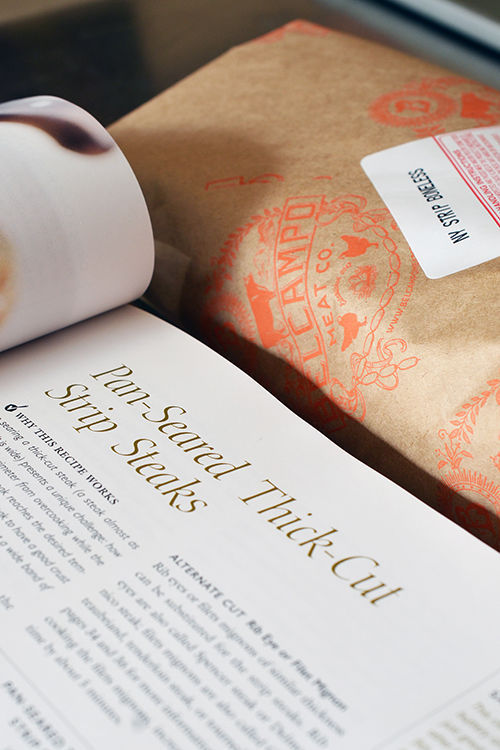
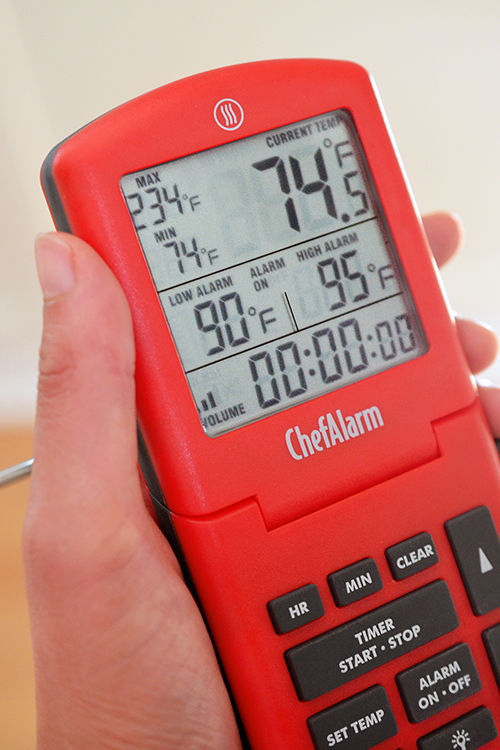

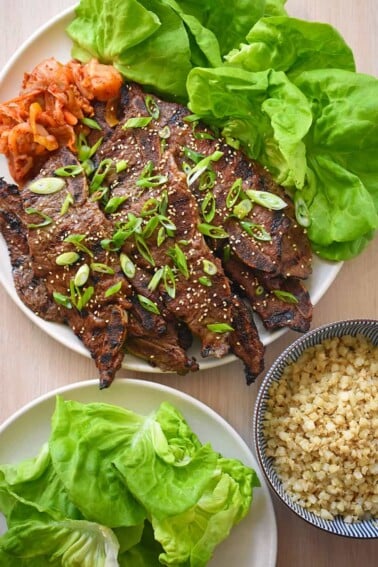
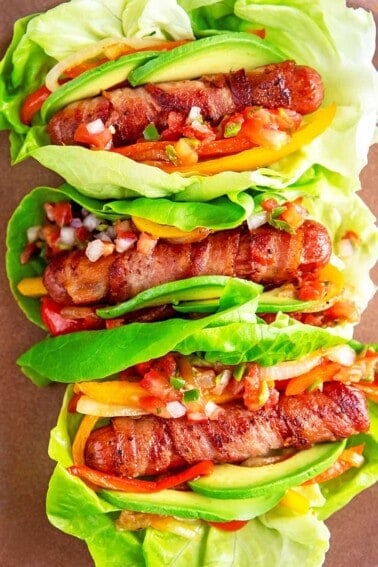


This came out absolutely perfect!!!
Thank you so much for posting this!!!
I found this, because I googled “can I sear a steak in ghee”
I was tired of setting off the smoke alarm.
No such problem tonight
Crispy crust without coating the steak in salt like they do on TV
My go to steak recipe since 2014!